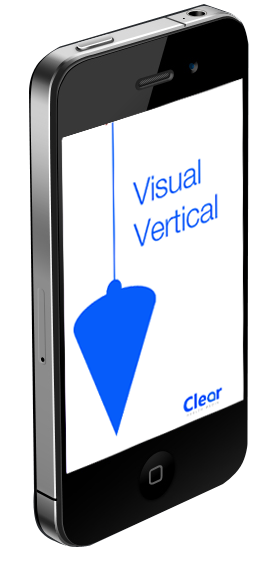Why Test Subjective Visual Vertical

The Easy, Accurate and Low-Cost way to measure
subjective visual vertical in your patients
Evidence
“a simple, quick, and useful method for detecting PVL (Peripheral Vestibular Lesions) in pediatric patients in the clinic setting.”
J.R. Brodsky, et al., Peripheral vestibular loss detected in pediatric patients using a smartphone-based test of the subjective visual vertical, Int. J. Pediatr. Otorhinolaryngol. (2015)
Also used in F. Gandor, D. Basta, D. Gruber, W. Poewe, and G. Ebersbach, “Subjective Visual Vertical in PD Patients with Lateral Trunk Flexion,” Parkinson’s Disease, vol. 2016, Article ID 7489105, 4 pages, 2016.
Reviews
"I would like to commend you for developing such a fantastic application...this application provides an invaluable “bedside” evaluation tool. As I am sure you aware previously such an assessment was only available through costly and inaccessible diagnostic laboratories."
Dr. Daniel Lane, BSc (Chiro) DC (UK) DACNB FFAAFN
Perth, Australia
"Visual vertical" ★★★★★
"Quick n easy, brilliant"
Baiju italia (Italy) (posted in iTunes)
"great tool" ★★★★★
"This is a great app- simple to use and easy to track. I will add this to my exam along with OPK+ and Tremor Tracer apps. Thanks!"
Nancy DC (USA) (posted in iTunes)
Deviations of subjective visual vertical have been shown to be a reliable clinical indicator of both peripheral (ear) and central nervous system lesions. (Bohmer & Mast 1999, Brodsky, Donahue et al 2006). Use of the Visual Vertical application allows subjective visual vertical to be tested quickly, easily and accurately in the clinician’s office.
Deviation of subjective visual vertical is also a component of the ocular tilt reaction. The ocular tilt reaction is a triad of signs consisting of a head tilt, binocular torsion and a tilt of subjective visual vertical all to the same side (Brodsky, Donahue et al 2006). (Click here for a diagram of the ocular tilt reaction.)
Various studies have shown that assessing subjective visual vertical along with other clinical indicators can allow accurate localisation of lesions in the central nervous system. Reviews of clinical cases by Brandt and Dietrich (1992) found that pontomedullary lesions produce ipsiversive tilts (deviation of subjective visual vertical toward the side of the lesion), and pontomesencephalic lesions produce contraversive tilts (away from the lesion). The deviations will usually be accompanied by the ocular tilt reaction. Disruption of both the otolithic and vertical semicircular canal pathways are thought to be involved in the deviations.
Thalamic lesions may produce either ipsiversive or contraversive tilts of subjective visual vertical. Lesions of the parietoinsular vestibular cortex tend to produce contraversive deviations. Lesions at the level of the thalamus and above will not produce an accompanying ocular tilt reaction (Brodsky, Donahue et al 2006).
Lesions in the inner ear also produce deviation of subjective visual vertical due to differences in the tonic output from the otolithic organs in the inner ear (Bohmer & Mast 1997).
In addition to assessment in neuro-otological disorders, subjective visual vertical has also been shown to be abnormal in headache sufferers, particularly those with migraine. (Asai 2009) This is consistent with earlier studies that have demonstrated balance deficits in migraineurs (Akdal, Donmez et al 2009). Thus testing of subjective visual vertical should be used in the evaluation of headache sufferers, and perhaps could be used an a clinical indicator of change in those using vestibular rehabilitation in migraineurs.
Use of the Visual Vertical application removes much of the difficulty and cost associated with subjective visual vertical testing, making it quick, easy and cost effective to integrate it into your practice. All that is required is an iphone, ipod touch or an ipad and some simple everyday items.

Click here to purchase this application in the App Store
Akdal, G., B. Donmez, et al. (2009). “Is balance normal in migraineurs without history of vertigo?” Headache 49(3): 419-425.
Asai, M., M. Aoki, et al. (2009). “Subclinical deviation of the subjective visual vertical in patients affected by a primary headache.” Acta Otolaryngol 129(1): 30-35.
Bohmer, A. and F. Mast (1999). “Assessing otolith function by the subjective visual vertical.” Ann N Y Acad Sci 871: 221-231.
Brandt, T. and M. Dieterich (1992). “Cyclorotation of the eyes and subjective visual vertical in vestibular brain stem lesions.” Ann N Y Acad Sci 656: 537-549.
Brodsky, M. C., S. P. Donahue, et al. (2006). “Skew deviation revisited.” Surv Ophthalmol 51(2): 105-128.

